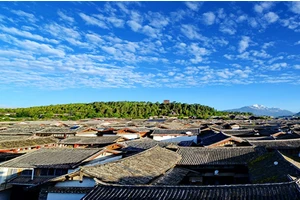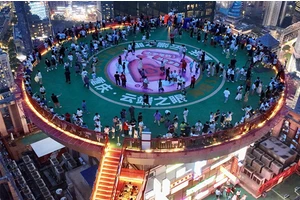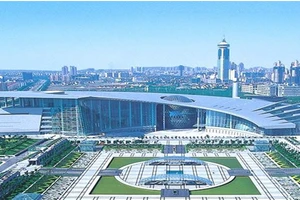Tourists visit sb.
< 1 > the beneficial impact of tourism on the environment
1. The favorable impact of tourism on the economic environment is the most significant. Compared with other industries, tourism is an industry with less investment, quick results and no pollution < compared with polluting industries >. At the same time, tourism can also promote the development of other industries, which makes tourism of great significance to the national economic income of this region.
2. The development of tourism can also increase local employment opportunities, make more people have jobs, solve a major employment problem in society, and reduce the frequency of social security incidents. At the same time, the entry of tourists from all over the world has increased the contacts and exchanges between local residents and foreigners, promoted mutual cultural exchanges, broadened their horizons and improved their cultural literacy.
3. Tourism also has obvious beneficial effects on the ecological environment. With the development of tourism, tourism resources are continuously developed, many of which have some ecological problems. In the development of tourism resources, measures of tourism ecological construction and pollution control can be taken to make the developed tourism resources have higher quality than the original ecological environment, that is, tourism development beautifies the ecological environment. Tourism can also maintain the ecological environment. If tourism resources are developed and put into use, they can be scientifically managed.
< 2 > the adverse effects of tourism on the environment
The negative impact of tourism on the environment is mainly manifested in: the impact on the atmosphere, the impact on the water environment, noise pollution, the damage and interference to animals and plants, the damage to the landscape environment and so on. A large number of facts show that tourism has become one of the environmental pollution sources, so it is necessary to summarize the main ways and particularity of tourism polluting the environment, and summarize the basic laws of tourism affecting the environment, thus providing a basis for strengthening environmental protection from the perspective of tourism management.
The emergence and development of tourism culture can not be separated from the influence of the environment at all times, and tourism culture also affects the environment at all times. The negative effects and impacts of the development of tourism culture on the environment are increasingly apparent, which has aroused people's general concern. The negative impact of tourism cultural activities on the environment has been paid much attention to in recent years, and many scholars at home and abroad have made relevant research on it. Here, we introduce eight negative impacts summarized by IUCN, as follows: (1) Impacts on the surface and soil.
With the development of tourism activities in various natural areas, the development of tourism facilities is increasing day by day, which has gradually divided many complete ecological areas into islands and made the ecological environment face unprecedented artificial transformation, such as surface pavement, vegetation renewal, introduction of exotic species and so on. Both land and water surface may be affected by tourism activities, and different surface covers such as rocky shores, beaches, wetlands, bogs, natural caves and soil may bear different types of tourism impacts, especially the soil organic layer on which surface plants depend is often the most severely impacted. Such as camping, picnicking and walking, will cause serious human disturbance to the soil. Once the soil is impacted, its physical structure, chemical composition and biological factors will change, which will eventually affect the species and growth of plants on the soil, and insects and animals will also migrate or decrease.
(B) the impact on plants
The impact of human tourism activities on surface vegetation and plants can be divided into two categories: direct impact and indirect impact. Direct influence behaviors include removal, trampling, fire, collection as campfire materials and harm to aquatic plants. Indirect effects include the introduction of exotic species, nutrient pollution, vehicle exhaust, soil erosion and other issues, which will indirectly affect the growth and health of plants.
1. Large area removal
This is the most direct harm to plants caused by human tourism activities. For example, in order to build hotels, parking lots or other tourist facilities, a large area of surface vegetation is removed, and even other soil is moved from other places to meet the engineering requirements, which is undoubtedly an act of destroying the family of plants.
2. Tourists trample on it
Among the effects of tourism activities on plants, tourists' trampling is the most common form. As soon as a tourist sets foot on a park or green space, his feet may put pressure on plants. After tourists visit the natural scenic spots, it is bound to change the plant population, even if it is used lightly, it will sometimes cause great changes. Tourists' trampling on plants will cause a series of related reactions. If it will affect the germination of plant seeds, the seedlings will not grow smoothly because the soil is trampled; For the grown plants, their physiology and morphology may be changed due to trampling; Unreasonable planning and design of footpaths may also affect the growth of endangered plant species; The vehicles that tourists take often leave car marks, which will change the composition of plants.
Step 3 collect
Collecting is also an act of harm to plants. The most common collecting motivation of tourists is to pick a beautiful flower, or to taste the fruit, or to bring some plants home for planting. In addition, many tourists are fascinated by the magical efficacy of plants, and pick them as soon as they see them in the wild, making many natural populations of medicinal plants less and less.
In addition, due to careless or poor management of tourists, forest fires may lead to a decline in vegetation coverage; Random felling of trees, bamboo huts, bamboo houses and firewood destroyed some young trees and changed the age structure of forest trees; The accumulation of a large amount of garbage will lead to the change of soil nutritional status, and will also cause air and light blockage and damage to the ecosystem.
(3) Effects on animals
The development of tourist areas may destroy the habitats or shelters of wild animals. After tourists arrive at the tourist area, both the tourist activities themselves and the noise made by tourists will interfere with the life and reproduction of wild animals. Moreover, ordinary tourists always like to "eat and take", love to eat all kinds of delicacies, and prefer to collect all kinds of wild animal products to show their domineering, so the lives of wild animals are threatened.
Step 1 interfere
When tourists engage in outdoor tourism activities, it will inevitably cause interference to the animals living in them, especially the sensitive birds and mammals. For example, the elephant valley in Xishuangbanna, due to the entry of large-scale tourists, has affected the life law of wild elephants, so that the wild elephants that often haunt the virgin forest stream are now only occasionally active here; Tourists engaged in water activities may also pose a threat to the waterfowl population, making them unable to hatch their eggs properly, resulting in temperature loss. Swan or waterfowl may also bruise the hook of the fisherman, or eat small lead blocks for fishing and die. The noise generated by tourists using various tourist facilities is also one of the major influencing factors, such as hand-held stereos, jet skis and motorboats, which have a great impact on animals; At the same time, various ships on the water may also produce oil pollution, thus affecting the survival of aquatic organisms. In addition, the activities of tourists on the beach will also affect the growth of animals, such as affecting the spawning behavior of turtles.
2. Consumption of wild animals
The impact of tourism activities on wild animals, among which tourists' consumption behavior on wild animals is the most serious. Chinese tourists not only eat seafood, but also love delicacies. As long as there is no poison, all kinds of rare birds and animals may become the target of tourists' hunting, resulting in the decline or even extinction of these ethnic groups. In addition to eating, tourists also like to buy related products of wild animals, such as animal fur, ivory and so on; There used to be all kinds of shellfish in many sea areas, but after a large number of them were eaten by people and made into various souvenirs, the number of shellfish dropped sharply.
(D) the impact on the water environment
Water environment plays an important role in tourism culture, so the influence of tourism activities on water environment is quite extensive and serious. Mainly reflected in the following aspects:
1. Oil pollution and garbage pollution from ships
One of the important reasons for the pollution of tourist water bodies is the garbage and oil pollution discharged by tourist ships. For example, in the Lijiang River in Guilin, during the peak tourist season, the tourist ships are almost end to end, forming a mighty "fleet", which not only destroys the artistic conception of swimming in the river, but also greatly exceeds the self-purification capacity of the Lijiang River, causing river pollution. Many waterside areas, such as seashore, spring point and riverside, have built resorts and leisure centers to develop tourism, and the sewage and garbage discharged from restaurants and hotels are also sources of water pollution.
2. Water sports
With the increasing prosperity of holiday tourism activities, water sports such as jet skis, boating, treading water, swimming, fishing, diving, diving, sailing, etc. in lakeside, riverside and spring point have greatly enriched people's holiday life, and at the same time brought great impact to the water environment. For example, motorcycle activities on the water not only erode the beach and coastline, but also affect the marine ecology such as plankton and fish in coral reefs. The leaked oil will also pollute the water body and even spread chemicals to threaten the health of aquatic organisms.
(5) Impact on the atmospheric environment
As tourists enter the tourist area and vehicles for tourists flock, a lot of toxic tail gas, dust and carbon dioxide exhaled by many tourists, as well as exhaust gas from domestic boilers such as hotels and restaurants in the tourist area, will cause serious pollution to the atmospheric environment in the tourist area.
1. Traffic pollution
Private transportation used by tens of thousands of tourists is the most inefficient mode of transportation, which not only consumes more resources, but also emits more air pollutants. Photochemical smog is the most harmful air pollution caused by this kind of vehicle. There are many highly reactive photochemical substances in photochemical smog, which will not only affect plants, but also endanger human health. When photochemical smog is serious, it will affect the line of sight, reduce visibility and cause tourists to be sleepy; Some substances it contains may irritate the eyes and cause uncomfortable feelings such as tears. In addition, the waste gas emitted by vehicles may also contain toxic substances, threatening the health of the earth's ecology. From the perspective of global climate change, exhaust emissions may lead to acid rain, greenhouse gases that warm the earth, or substances that induce ozone hole.
2. Solid wastes such as garbage
Solid wastes, such as garbage, have high organic content. If they are not handled properly, they will breed bacteria and viruses, especially the organic matter piled at the bottom. Due to severe hypoxia, anaerobic bacteria multiply rapidly, pathogenic bacteria breed and produce stench. Poor management of tourist public toilets will also produce stench and increase the number of bacteria in the atmosphere.
3. Air pollution in a closed environment
Such as caves, restaurants, entertainment places, etc., are not only affected by the external atmosphere, but also by the discharge of internal pollutants, such as carbon dioxide and water vapor released by tourists breathing and carrying viruses and bacteria, carbon dioxide and smoke increased by smoking, a large number of positive ions released by using electronic equipment, harmful substances released by decoration, carbon monoxide, sulfur dioxide and smoke emitted by heating, etc., because of poor air flow, the air is dirty, which makes people have headaches, tightness, loss of appetite and mental health.
4. The pollution of tourist facilities to the atmospheric environment
Tourist hotels and restaurants are necessary living service facilities for any kind of tourism. The pollution sources to the atmosphere are mainly water supply, heat supply, boiler chimneys for energy supply, exhaust gas from coal stoves, exhaust gas from food stalls in tourist areas, etc., and the main pollutants released are sulfur dioxide, nitrogen dioxide, carbon monoxide and soot generated by burning coal, gas and liquefied gas. Although the total amount is small in industry, the emission sources are scattered, low in height, close to scenic spots, and there are no dust removal facilities.
(VI) Impact on environmental sanitation
The impact of tourism activities on environmental health is mainly manifested in solid waste pollution. In many scenic spots, people can see all kinds of solid wastes discarded by tourists everywhere. Garbage pollution has become a great scourge in many scenic spots in China, and it is a very common and difficult problem.
Chinese tourists always like to take all kinds of food, such as snacks, sweets, drinks, etc. outdoors, or eat and drink in local produce shops and seafood shops near tourist areas, which creates a lot of garbage for the local environment. About 6000 tons of business garbage and 2000 tons of tourist garbage are dumped into streams and water bodies in the tourist area every year in Hengshan Mountain, Nanyue. Some mountain valleys have almost become trash cans for mountaineers to throw away debris. The garbage in the valley is difficult to deal with, and it stinks over time. In addition, the disposal of these wastes is also a big problem, because "no waste disposal method is completely safe". For example, the treatment equipment consumes electricity and energy, and some pollution prevention equipment will produce secondary public hazards (such as the incinerator may discharge waste gas containing toxic substances), which will threaten the environment again and even damage public health.
(VII) Impact on environmental aesthetics
The bad influence of tourism activities on environmental aesthetics mainly lies in the uncivilized tourism behavior of tourists and the unreasonable development and construction of tourism.
1. Uncivilized tourism behavior of tourists
Some tourists not only see, hear and smell, but also have the bad habit of lettering and painting on ancient trees, inscriptions and stones. Engraving as a souvenir can be said to be the most common bad habit of tourists, which not only destroys the landscape, but also affects the growth of some plants and reduces the value of cultural tourism resources. For example, on the rock walls of many scenic spots in our country, we can appreciate the ingenious carving skills of nature, but we can often see the heart-shaped patterns of "a visit here" or "love", which gives people the feeling of spoiling the scenery. For another example, concentric locks are very popular in Huangshan Scenic Area in China. Couples buy concentric locks and hang them on the irons beside the trees. The poor giant trees are surrounded by strings of metal, and the natural artistic conception of the towering ancient trees is completely destroyed.
2. Unreasonable development and construction of tourism
Improper planning or over-exploitation of tourism facilities construction projects will destroy the original local landscape environment, which is called "development pollution". The essence of tourism development is to add artificial buildings on the basis of natural landscapes or original scenic spots to meet the needs of tourism activities. However, nowadays, many tourism developments only consider the aesthetic characteristics that cater to the subjective interests of tourists, and ignore or simply ignore the coordination between the project construction and the surrounding landscape environment, thus causing damage to the landscape environment of the area. For example, Taishan Mountain in Shandong, Xishan Mountain in Beijing, Songshan Forest Park in Zhongyue, etc., ropeways are suspended and telephone poles are inserted into the sky, which seriously destroys the original expression of mountain scenic spots; Putuo Mountain in Zhejiang Province is one of the four famous Buddhist mountains in China. In the past, "everyone saw temples and temples, and everyone was a monk and nun". Now, there are many stalls on the mountain and under the mountain, modern entertainment facilities are all over the mountain, pop music has drowned out the Sanskrit coming from the temple, foreign buildings compete with temples and temples, and rock and roll resonate with Sanskrit. This scene is far from the Buddhist holy land. The Tianxing Scenic Area, 7 kilometers downstream of Huangguoshu Waterfall, has built a tea room with an oversized yellow glazed tile roof, which is out of harmony with the characteristics of a natural karst bonsai park in the scenic area, destroying the natural beauty and violating the laws of nature.
(VIII) Impact on social and cultural environment
1. Damage to cultural relics and historic sites
First of all, because some tourists are not well educated, they don't realize the preciousness and irreplaceability of cultural relics, and uncivilized behaviors such as blindly depicting cultural relics or sitting on cultural relics and taking pictures will cause the loss and destruction of cultural relics to varying degrees. Secondly, the carbon dioxide gas exhaled by many tourists during the tour contains a lot of water, which erodes cultural relics, especially the murals and statues in some ancient caves and Buddhist grottoes. Because of the high humidity in caves and grottoes, and the large amount of water brought by the breathing of many tourists, the corrosion rate of precious murals and statues has been accelerated. In addition, the flash of the camera, the sweat and fingerprints of millions of tourists will also corrode murals and statues. For example, the famous Dunhuang Grottoes, damaged and corroded by the camera flash and the sweat, breath (carbon dioxide) and fingerprints of millions of tourists, have lost their luster and become dim, and the red and flesh colors have gradually turned black.
Thirdly, the footholds of many tourists will also damage cultural relics and historic sites. For example, the Great Wall of Wan Li in China has been damaged by a large number of tourists for a long time, and many places have been seriously damaged; The Forbidden City in Beijing, due to the endless stream of tourists, once trampled the bricks in the main hall out of the pit, and the bricks in the squares and passages were also badly damaged. It is estimated that the "bricks" paved in the Forbidden City wear up to 10~20 mm every year; The colorful corridor of the Summer Palace winding over 700 meters, and the bricks on the pavement will be replaced once every few years.
2. Impact on the values and living habits of local residents.
With the development of tourism activities, tourists will inevitably bring their lifestyle to their destinations. Specifically, some people gradually have negative changes in their thoughts and behaviors by observing the behavior of visiting tourists. They began to be dissatisfied with their traditional way of life, and yearned for the way of life of visiting tourists. First, they blindly imitated their costumes and entertainment methods, and then they developed into conscious pursuits, thus increasing crimes and unhealthy social phenomena such as gambling, prostitution, speculation and fraud, corruption and bribery, smuggling and drug trafficking, and affecting the security of social order. In addition, due to the influence of western liberal ideas, traditional moral concepts and values have been impacted, resulting in an increase in marriage breakdown and an increase in divorce rate.
3. Excessive commercialization of traditional culture
Traditional folk customs and celebrations are held at a specific time and place in accordance with the contents and methods stipulated by the tradition. However, with the development of tourism, many of these activities are gradually commercialized, and they are no longer held in accordance with the traditional time and place. In order to receive tourists, they will be put on the "stage" at any time. In order to cater to tourists' viewing interests, the content of the activities is often compressed, and the pace of performances is obviously accelerated. Therefore, although these activities have been preserved, they have largely lost their traditional significance and value. For example, when the Dai people's Water-splashing Festival was moved to Kunming "Country Park" for the development of tourism and cultural activities, it became a "Water-pouring Festival": tourists each took buckets and basins, poured water from each other's heads to the soles of their feet, or pushed people into the pool, and a circle of people "splashed" around, completely losing the "willow branches sprinkling water" to show the cultural artistic conception of blessing.
4. Induce the contradiction between subject and object
In the process of developing tourism, with the increasing contact between tourists and local residents, it will inevitably cause some psychological conflicts and contradictions, especially for local residents, which will be more obvious. For example, when tourists are overcrowded in a tourist area, or tourists' behavior is so rude that it affects the daily life of local residents, residents will complain. The complaints they often hear are: personal privacy exposure, insufficient parking lots, traffic jams, congestion, noise, dirty environment, increased garbage, rising local prices, and more thieves.
Tourists are the main body of tourism and the basic elements of the three major elements of tourism. Without tourists, natural tourism cannot be realized. Tourists, literally, are tourists, that is, people engaged in tourism activities. That is, "people who have left their country of residence to visit another country for more than 24 hours". According to this standard definition, the so-called businessmen, government officials and athletes are also foreign tourists.
Therefore, a tourist is a person who temporarily leaves his permanent residence and takes pleasure in spiritual pleasure through sightseeing, recreation and other activities. You can stay in a homestay with local ethnic characteristics, and you can book it through the small program "Travel House". Tourism often involves travelling across mountains and rivers. Although the process is very tiring, it brings people more spiritual and physical pleasure, such as enjoying the scenery, tasting delicious food, staying in a hotel and so on.






